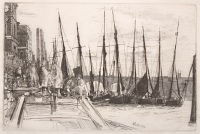Etchings Institutions search term: royal collection
Billingsgate | ||
| Number: | 51 | |
| Date: | 1859 | |
| Medium: | etching and drypoint | |
| Size: | 152 x 223 mm | |
| Signed: | 'Whistler.' to right of centre | |
| Inscribed: | '1859.' at lower right | |
| Set/Publication: | 'The Portfolio', London, 1878 | |
| No. of States: | 9 | |
| Known impressions: | 125 | |
| Catalogues: | K.47; M.46; T.34; W.45 | |
| Impressions taken from this plate (125) | ||
KEYWORD
TITLE
'Billingsgate' (1863, Whistler). 1
'Billingsgate Market' (1874, Ralph Thomas, Jr (1840-1876)). 2
'Billingsgate' (1878, Portfolio). 3
'Billingsgate Market' (1881, Union League Club). 4
'Billingsgate' (1886, Frederick Wedmore (1844-1921)). 5
'Billingsgate' is the preferred title, accepted by the majority of cataloguers.
1: Whistler to W. H. Carpenter, 3 August 1863, GUW #11109.
2: Thomas 1874 (cat. no. 34).
3: The Portfolio..., P. G. Hamerton, ed., January 1878, vol. 9, f. p. 8.
4: New York 1881 (cat. no. 65)
5: Wedmore 1886 A (cat. no. 45).
DESCRIPTION
SITE
6: Lochnan 1984 , p. 83.
DISCUSSION
7: 'English Etching', The Standard, London, 25 April 1878, p. 2 (GUL PC1/94).
8: The Academy, 19 November 1881, p. 390.
